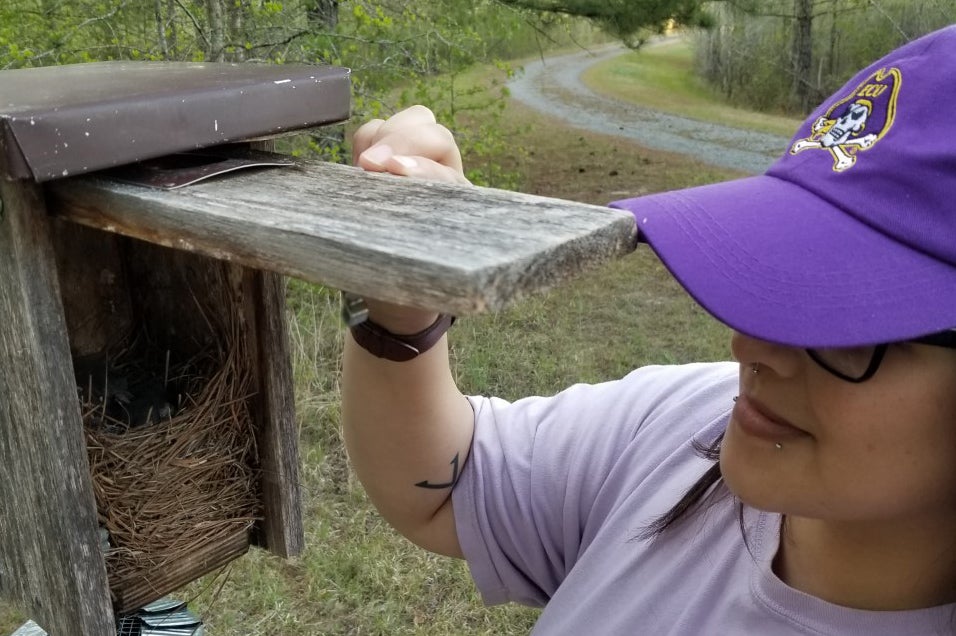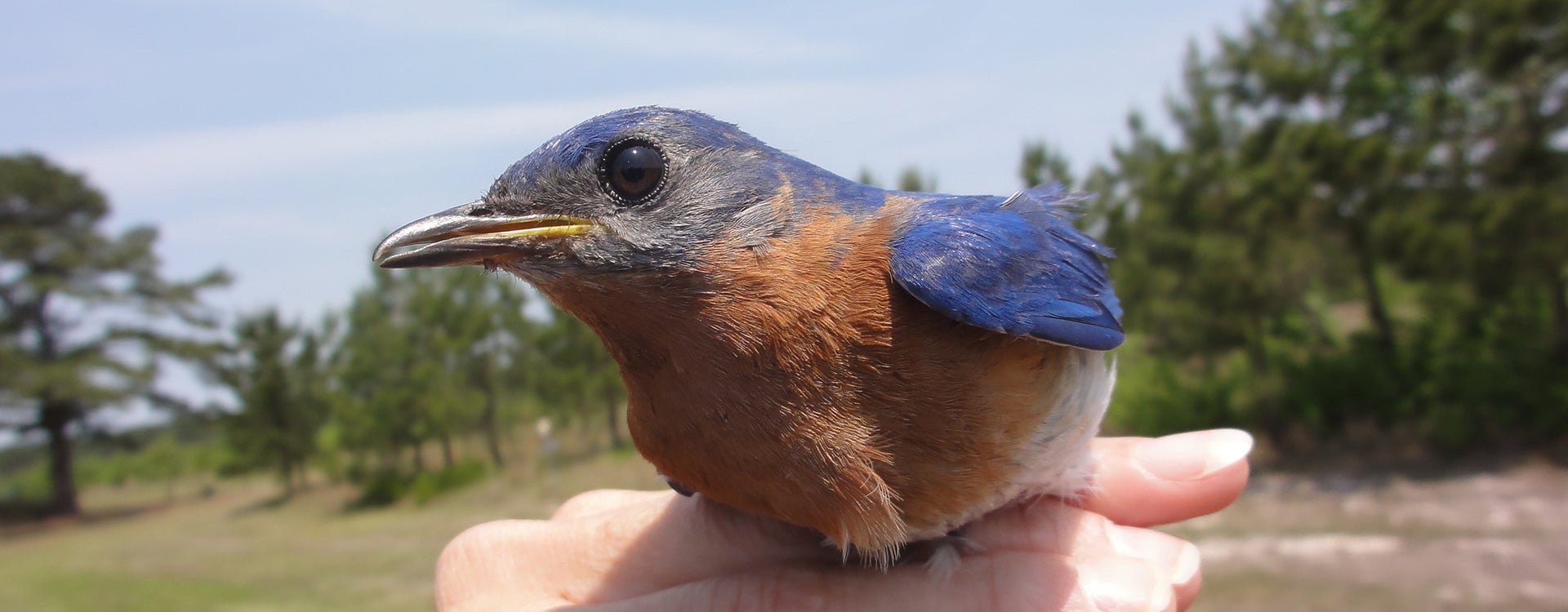BOON FOR BLUEBIRDS
Biology students monitor birds’ nesting habits, characteristics
A decade ago, Dr. Sue McRae, teaching associate professor in East Carolina University’s Department of Biology, had 30 bluebird boxes installed at the university’s West Research Campus to provide learning opportunities for a field zoology class. Since then her students have conducted a variety of research projects, and the birds have thrived at the site.
“We looked at the return of birds in the spring migration at the research campus, and I taught them how to identify birds. We were basically looking at the accumulation of different species of birds coming back annually,” as well as the insects that provided the birds’ food source, McRae said. “We put out these boxes thinking, ‘Here’s something else we can sample. Who is colonizing these boxes and at what time?’”
McRae said she knew eastern bluebirds — and other species — would use the boxes, but she had no idea how successful the project would be. The species isn’t threatened but did suffer a decline in the 1950s due to pesticides and the impact of invasive species from Europe such as starlings and house sparrows, which often outcompete bluebirds for the available nesting cavities in a given habitat.
The boxes were built with smaller openings to exclude those larger species, and the bluebirds have taken advantage. Even in the first year, McRae said, most of the boxes were claimed, and mostly by eastern bluebirds.
“If they’re that nest-cavity limited that they colonized all our boxes the first time we put them out, then this is a good place to do this,” McRae realized. “So we’ve been doing it ever since.”
(ECU file video, 2019; visit on YouTube for closed-captioning)
McRae and her students put the boxes out each year before spring break and then leave them alone for about 10 days for the birds to settle in.
“And then when we come back to start doing box checks, usually a fair number of boxes have been claimed by bluebird pairs,” she said. “It turns out we pretty regularly get 25 and sometimes all 30 boxes colonized by the end of the semester.”
The colony has provided a wealth of hands-on research opportunities.
“The undergrads handle the chicks, banding them, measuring them, taking data from the nesting,” McRae said.

Dr. Sue McRae has spent the last decade monitoring bluebird nests with her students.
Each year she focuses on a different question about nesting behaviors or characteristics, and a number of students have done honors theses on specific aspects of the project. They’ve tracked when the birds arrive, when they lay and how many broods they have each season, and they even take blood samples to examine genetic data.
“I had one student do a thesis that investigated why their nests vary in size, and she came up with some really innovative results,” McRae said. Another worked on laying times — bluebirds generally lay their eggs later in the morning than most other species, but the time varies among individual birds.
Because all the birds at the site have been banded since 2011, the project has generated good familial data and the chance to study characteristics that are passed on from one generation to the next.
Sarah Akers’ project — funded by an Undergraduate Research and Creativity Award — focuses on the genes responsible for bluebird egg coloration.
“Bluebirds typically lay light blue-green eggs,” Akers said. “A small few of them — less than 5% — lay white eggs. We are fortunate to have had some white egg-layers at our field site. I am hoping that identifying the mutation that causes the white eggs, or absence of color, will show me what genes are responsible for their egg coloration.”
Akers said participating in the research helped her find her place at ECU.
“My lab partners have become my circle of friends,” she said. “In addition to gaining colleagues, it also gives me a feeling of being a part of something larger than myself. The bluebird study has been going on for more than 10 years. The opportunity to contribute to that project, and the scientific community as a whole, feels like a unique privilege.”
With in-person classes and lab time shut down because of COVID-19, Akers said the project has also provided a shred of normalcy. Because the students conduct the nest checks individually anyway, McRae received approval early on to continue with that part of the project.

Biology student Sarah Akers checks a bluebird nest at ECU’s West Research Campus.
“I get some fresh air, exercise and sunshine,” Akers said. “It is almost the only reason I leave the house.”
In addition to the data collected over time and the student research opportunities, McRae said there’s one bird whose story shows how successful the site has been for the birds.
“Two years ago one of the male bluebirds from the previous year stayed as a helper to rear his little brothers and sisters,” she said. “It’s called helping behavior, and it’s a phenomenon in social evolution … but it doesn’t usually happen in eastern bluebirds.”
Usually the young disperse and become breeders somewhere else the following year.
“To have one stay on and help his parents rear siblings is very unusual for this species, and it’s clear evidence that we’ve grown that population,” McRae said. “It’s an indication that our injection of boxes into that habitat has addressed a limiting factor for their reproduction, and that grew the population.”
The following year the bird’s parents were gone, and he returned as a breeder to the same box.
Between the research opportunities, the data compiled, and the impact on the population, it’s clear that the boxes at ECU’s West Research Campus have been a boon for the bluebirds and the students alike.
